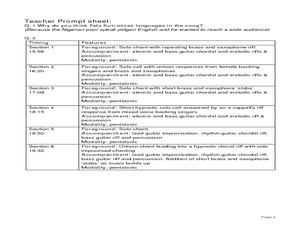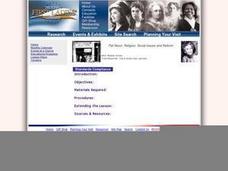Curated OER
Women’s Rights – Reading Questions
In this women's rights worksheet, students respond to 8 short answer questions about women's history in the United States based on assigned textbook reading.
Curated OER
African-American Civil Rights in the U.S.
In this African American history worksheet, students respond to 39 identification questions that require them to define or list the significance behind 39 events and people associated with the American Civil Rights Movement.
Curated OER
IB History of the Americas—Overview of the Mexican Revolution
In this Mexican history worksheet, students respond to 17 fill in the blank and short answer questions about leaders and events during the Mexican Revolution.
Curated OER
Cartoons for the Classroom: Between the Lines, Debt Crisis
In this European debt crisis activity, students analyze a political cartoon about Greek debt and respond to 3 talking point questions.
Curated OER
Cartoon Analysis Worksheet Key Jay’s Treaty
In this primary source analysis worksheet, students examine a political cartoon about Jay's Treaty and then respond to 10 analysis questions about the cartoons they select. The cartoon is not included and answers to each of the questions...
Curated OER
No Second Troy Questions
In this poetry analysis worksheet, students interpret “No Second Troy,” by William Butler Yeats by answering 5 questions based on the relationships featured in the poem.
Curated OER
Cinderella
In this "Cinderella" worksheet, students read the story, answer comprehension, discussion and extension questions and conduct simple research on another "Cinderella" story.
Penguin Books
Gulliver's Travels Teacher's Notes
Who are "the most pernicious race of little odious vermin that nature ever suffered to crawl upon the surface of the earth”? Readers of Gulliver’s Travels will learn the answer, as the journey with Lemuel Gulliver to Lilliput,...
Curated OER
Who Sees The Art? (Mural Option)
Students identify the intended viewers of local murals or billboards. The teacher next shares information and leads a discussion about the patrons. They group themselves according to protest or persuasion issues that concern them.
Curated OER
Individual Rights -- Freedom of Speech at School
High schoolers examine their individual rights at a public school. In groups, they identify the most common ways of expressing themselves and why they should limit their speech in public. They compare and contrast two cases in which they...
Curated OER
The Stamp Act/Taxation Without Representation
Fourth graders discuss the Stamp Act and the preamble. In this social science lesson, 4th graders examine protests and show that the colonists reacted to the Stamp Act by protesting. Students study various cartoons and state what the...
Curated OER
Comparing the Confessional traditions that Emerge from the Reformation
Ninth graders examine the Protestant Reformation. In this World History activity, 9th graders research various places of worship. Students comapre and contrast the different sects of religion that resulted from the Protestant...
Curated OER
Songs of Fela Kuti – Nigeria
Students explore the music of Fela Kuti. In this music lesson, students listen to the fusion protest music of Fela Kuti of Nigeria. Students reflect on Kuti's music and message.
Curated OER
Martin Luther King Jr. and Nonviolence
Students explore a local seat of government to examine ways to make changes in their communities. In this local government lesson, students read about Martin Luther King, Jr. and his nonviolent protests. Students read important dates and...
Curated OER
Breaking News English: Indian Policewomen Slap Dating Couples
In this English worksheet, students read "Indian Policewomen Slap Dating Couples," and then respond to 47 fill in the blank, 7 short answer, 20 matching, and 8 true or false questions about the selection.
Curated OER
We're Finally on our Own: May 4, 1970
Students examine photos of the Kent State University unrest of the 1970's and discuss what the photos represent. They complete a written assessment.
Curated OER
Loud and Clear
Students brainstorm various forms of protest, examine the context for President George W. Bush's visit to Britain, and research protests throughout history. Students use the information gathered to create informative posters and diary...
National First Ladies' Library
Science: The Purloined Letter
Students examine Edgar Allan Poe's "the Purloined Letter" from the perspective of a profiler. To sharpen search procedures, they examine the text and make lists of items and places in the house that were searched. Then students discuss...
Curated OER
Breaking News English: World Naked Bike Ride Against Oil Use
In this English worksheet, students read "World Naked Bike Ride Against Oil Use," and then respond to 47 fill in the blank, 7 short answer, 20 matching, and 8 true or false questions about the selection.
Curated OER
Ordinary People, Ordinary Places: The Civil Rights Movement
Students analyze Martin Luther King's message of nonviolent protest discover how individuals adapted his message to their own communities and situations.
Curated OER
Breaking News English: Violence Erupts Across Egypt
In this English activity, students read "Violence Erupts Across Egypt," and then respond to 1 essay, 47 fill in the blank, 7 short answer, 20 matching, and 8 true or false questions about the selection.
Curated OER
Discovery Channels
Students read a New York Times article in order to explore issues about the celebration of Columbus Day. They, working in groups, research the legacy of exploration and colonization. They use the research to create a first person narrative.
Curated OER
First Amendment or Treason?
Young scholars investigate the meaning of the First Amendments right of freedom of speech. They examine the anti-war movement that occurred during the 1960's in response to the war in Vietnam. While studying primary sources, they...
Curated OER
Discussion Guide: Grades 9-12
Students discover that wars and human rights abuses are going on around the world every day. They discuss how the media decide what should be covered and what should not?

























